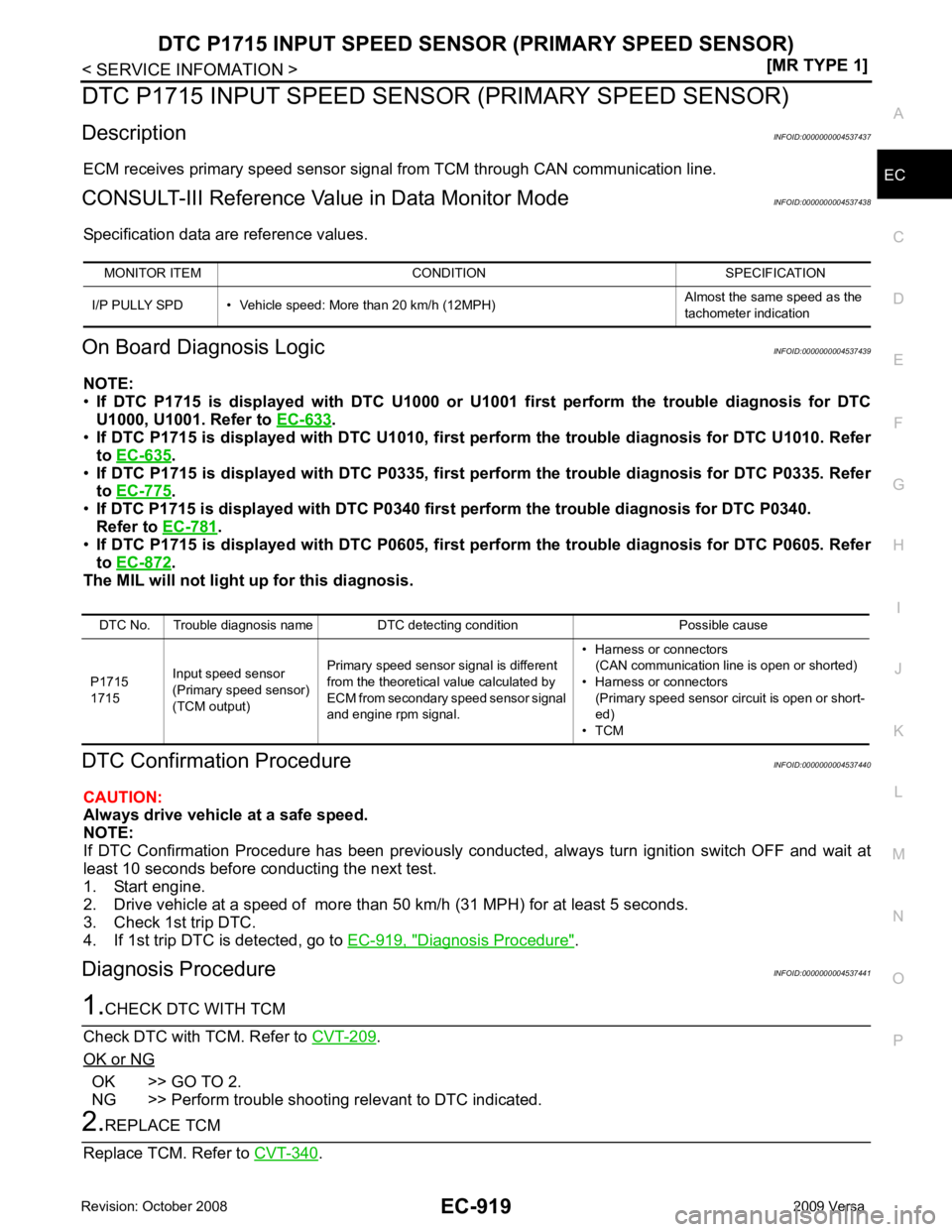2009 NISSAN LATIO turn signal
[x] Cancel search: turn signalPage 2263 of 4331

EC
NP
O
DTC P1572 ASCD BRAKE SWITCH
Component Description INFOID:0000000004537422
When the brake pedal is depressed, ASCD brake switch (2) is
turned OFF and stop lamp switch (1) is turned ON. ECM detects the
state of the brake pedal by this input of two kinds (ON/OFF signal).
Refer to EC-524 for the ASCD function.
CONSULT-III Reference Val ue in Data Monitor Mode INFOID:0000000004537423
Specification data are reference values.
On Board Diagnosis Logic INFOID:0000000004537424
This self-diagnosis has the on e trip detection logic.
The MIL will not light up for this diagnosis.
NOTE:
• If DTC P1572 is displayed with DT C P0605, first perform the trouble diagnosis for DTC P0605. Refer
to EC-872 .
• This self-diagnosis has the one trip detection logic. When malfunction A is detected, DTC is not
stored in ECM memory. And in that case, 1st trip DTC and 1st trip freeze frame data are displayed.
1st trip DTC is erased when igniti on switch OFF. And even when ma lfunction A is detected in two
consecutive trips, DTC is not stored in ECM memory. DTC No.
Trouble Diagnosis
Name DTC Detecting Condition Possible Cause
P1572
1572 ASCD brake switch A)
When the vehicle speed is above 30km/h (19
MPH), ON signals from the stop lamp switch
and the ASCD brake switch are sent to ECM
at the same time. • Harness or connectors
(Stop lamp switch circuit is shorted.)
• Harness or connectors (ASCD brake switch circuit is shorted.)
• Harness or connectors
(ASCD clutch switch circuit is shorted.)
(M/T)
• Stop lamp switch
• ASCD brake switch
• ASCD clutch switch (M/T)
• Incorrect stop lamp switch installation
• Incorrect ASCD brake switch installation
• Incorrect ASCD clutch switch installation (M/T)
• ECM
B)
ASCD brake switch signal is not sent to ECM
for extremely long time while the vehicle is
driving
Page 2268 of 4331
![NISSAN LATIO 2009 Service Repair Manual EC-912< SERVICE INFOMATION >
[MR TYPE 1]
DTC P1572 ASCD BRAKE SWITCH
2. Disconnect ASCD brake switch (2) harness connector.
- Stop lamp switch (1)
3. Turn ignition switch ON.
4. Check voltage betwee NISSAN LATIO 2009 Service Repair Manual EC-912< SERVICE INFOMATION >
[MR TYPE 1]
DTC P1572 ASCD BRAKE SWITCH
2. Disconnect ASCD brake switch (2) harness connector.
- Stop lamp switch (1)
3. Turn ignition switch ON.
4. Check voltage betwee](/manual-img/5/57359/w960_57359-2267.png)
EC-912< SERVICE INFOMATION >
[MR TYPE 1]
DTC P1572 ASCD BRAKE SWITCH
2. Disconnect ASCD brake switch (2) harness connector.
- Stop lamp switch (1)
3. Turn ignition switch ON.
4. Check voltage between ASCD brake switch terminal 1 and ground with CONSULT-III or tester.
OK or NG OK (M/T models) >>GO TO 6.
OK (A/T and CVT m odels) >>GO TO 7.
NG >> GO TO 5. 5.
DETECT MALFUNCTIONING PART
Check the following.
• Harness connectors M69, E7
• 10A fuse
• Harness for open or short between ASCD brake switch and fuse
>> Repair open circuit or short to ground or short to power in harness or connectors. 6.
CHECK ASCD BRAKE SWITCH INPUT SIGNAL CIRCUIT FOR OPEN AND SHORT
1. Turn ignition switch OFF.
2. Check harness continuity between ASCD brake switch terminal 2 and ASCD clutch switch terminal 1.
Refer to Wiring Diagram.
3. Also check harness for short to ground and short to power.
OK or NG OK >> GO TO 8.
NG >> Repair open circuit or short to ground or short to power in harness or connectors. 7.
CHECK ASCD BRAKE SWITCH INPUT SIGNAL CIRCUIT FOR OPEN AND SHORT
1. Turn ignition switch OFF.
2. Disconnect ECM harness connector.
3. Check harness continuity between ECM terminal 100 and ASCD brake switch terminal 2.
Refer to Wiring Diagram.
4. Also check harness for short to ground and short to power.
OK or NG OK >> GO TO 8.
NG >> Repair open circuit or short to ground or short to power in harness or connectors. 8.
CHECK ASCD BRAKE SWITCH
Refer to EC-914, " Component Inspection " . BBIA0708E
Voltage: Battery voltage
PBIB0857E
Continuity should exist.
Continuity should exist.
Page 2269 of 4331
![NISSAN LATIO 2009 Service Repair Manual DTC P1572 ASCD BRAKE SWITCH
EC-913
< SERVICE INFOMATION >
[MR TYPE 1] C
D E
F
G H
I
J
K L
M A EC
NP
O
OK or NG OK >> GO TO 15.
NG >> Replace ASCD brake switch. 9.
CHECK ASCD CLUTCH SWITCH INPUT SIGNAL NISSAN LATIO 2009 Service Repair Manual DTC P1572 ASCD BRAKE SWITCH
EC-913
< SERVICE INFOMATION >
[MR TYPE 1] C
D E
F
G H
I
J
K L
M A EC
NP
O
OK or NG OK >> GO TO 15.
NG >> Replace ASCD brake switch. 9.
CHECK ASCD CLUTCH SWITCH INPUT SIGNAL](/manual-img/5/57359/w960_57359-2268.png)
DTC P1572 ASCD BRAKE SWITCH
EC-913
< SERVICE INFOMATION >
[MR TYPE 1] C
D E
F
G H
I
J
K L
M A EC
NP
O
OK or NG OK >> GO TO 15.
NG >> Replace ASCD brake switch. 9.
CHECK ASCD CLUTCH SWITCH INPUT SIGNAL CIRCUIT FOR OPEN AND SHORT
1. Turn ignition switch OFF.
2. Disconnect ECM harness connector.
3. Check harness continuity between ECM terminal 100 and ASCD clutch switch terminal 2.
Refer to Wiring Diagram.
4. Also check harness for short to ground and short to power.
OK or NG OK >> GO TO 10.
NG >> Repair open circuit or short to ground or short to power in harness or connectors. 10.
CHECK ASCD CLUTCH SWITCH
Refer to EC-914, " Component Inspection "
OK or NG OK >> GO TO 15.
NG >> Replace ASCD clutch switch. 11.
CHECK STOP LAMP SWITCH POWER SUPPLY CIRCUIT
1. Turn ignition switch OFF.
2. Disconnect stop lamp switch (1) harness connector.
- ASCD brake switch (2)
3. Check voltage between stop lamp switch terminal 1 and ground with CONSULT-III or tester.
OK or NG OK >> GO TO 13.
NG >> GO TO 12. 12.
DETECT MALFUNCTIONING PART
Check the following.
• Harness connectors M69, E7
• 10A fuse Continuity should exist.
BBIA0708E
Voltage: Battery voltage PBIB3317E
Page 2275 of 4331

EC
NP
O
DTC P1715 INPUT SPEED SENS
OR (PRIMARY SPEED SENSOR)
Description INFOID:0000000004537437
ECM receives primary speed sensor signal from TCM through CAN communication line.
CONSULT-III Reference Val ue in Data Monitor Mode INFOID:0000000004537438
Specification data are reference values.
On Board Diagnosis Logic INFOID:0000000004537439
NOTE:
• If DTC P1715 is displayed with DTC U1000 or U 1001 first perform the trouble diagnosis for DTC
U1000, U1001. Refer to EC-633 .
• If DTC P1715 is displayed with DTC U1010, firs t perform the trouble diagnosis for DTC U1010. Refer
to EC-635 .
• If DTC P1715 is displayed with DT C P0335, first perform the trouble diagnosis for DTC P0335. Refer
to EC-775 .
• If DTC P1715 is displayed with DTC P0340 firs t perform the trouble diagnosis for DTC P0340.
Refer to EC-781 .
• If DTC P1715 is displayed with DT C P0605, first perform the trouble diagnosis for DTC P0605. Refer
to EC-872 .
The MIL will not light up for this diagnosis.
DTC Confirmation Procedure INFOID:0000000004537440
CAUTION:
Always drive vehicle at a safe speed.
NOTE:
If DTC Confirmation Procedure has been previously conduc ted, always turn ignition switch OFF and wait at
least 10 seconds before conducting the next test.
1. Start engine.
2. Drive vehicle at a speed of more than 50 km/h (31 MPH) for at least 5 seconds.
3. Check 1st trip DTC.
4. If 1st trip DTC is detected, go to EC-919, " Diagnosis Procedure " .
Diagnosis Procedure INFOID:0000000004537441.
OK or NG OK >> GO TO 2.
NG >> Perform trouble shooting relevant to DTC indicated. .
MONITOR ITEM CONDITION SPECIFICATION
I/P PULLY SPD • Vehicle speed: More than 20 km/h (12MPH) Almost the same speed as the
tachometer indication DTC No. Trouble diagnosis name DTC detecting condition Possible cause
P1715
1715 Input speed sensor
(Primary speed sensor)
(TCM output) Primary speed sensor signal is different
from the theoretical value calculated by
ECM from secondary speed sensor signal
and engine rpm signal. • Harness or connectors
(CAN communication line is open or shorted)
• Harness or connectors (Primary speed sensor circuit is open or short-
ed)
• TCM
Page 2277 of 4331

EC
NP
O
DTC P1805 BRAKE SWITCH
Description INFOID:0000000004537442
Brake switch signal is applied to the ECM through t he stop lamp switch when the brake pedal is depressed.
This signal is used mainly to decrease the engine speed when the vehicle is driving.
CONSULT-III Reference Val ue in Data Monitor Mode INFOID:0000000004537443
Specification data are reference values.
On Board Diagnosis Logic INFOID:0000000004537444
The MIL will not light up for this self-diagnosis.
FAIL-SAFE MODE When the malfunction is detected, the ECM enters in fail-safe mode.
DTC Confirmation Procedure INFOID:0000000004537445
1. Turn ignition switch ON.
2. Fully depress the brake pedal for at least 5 seconds.
3. Erase the DTC.
4. Check 1st trip DTC.
5. If 1st trip DTC is detected, go to EC-923, " Diagnosis Procedure " .
MONITOR ITEM CONDITION SPECIFICATION
BRAKE SW • Ignition switch: ON Brake pedal: Fully released OFF
Brake pedal: Slightly depressed ON DTC No. Trouble diagnosis name DTC detecting condition Possible cause
P1805
1805 Brake switch A brake switch signal is not sent to ECM for
extremely long time while the vehicle is driv-
ing. • Harness or connectors
(Stop lamp switch circuit is open or shorted.)
• Stop lamp switch Engine operation condition in fail-fail safe mode
ECM controls the electric throttle control actuator by regulating the throttle opening to a small range. Therefore, acceleration will be poor.
Vehicle condition Driving condition Engine: Idling NormalAccelerating Poor acceleration
Page 2280 of 4331
![NISSAN LATIO 2009 Service Repair Manual EC-924< SERVICE INFOMATION >
[MR TYPE 1]
DTC P1805 BRAKE SWITCH
>> Repair open circuit or short to ground or short to power in harness or connectors. 4.
CHECK STOP LAMP SWITCH INPUT SIGNAL CIRCUIT FOR NISSAN LATIO 2009 Service Repair Manual EC-924< SERVICE INFOMATION >
[MR TYPE 1]
DTC P1805 BRAKE SWITCH
>> Repair open circuit or short to ground or short to power in harness or connectors. 4.
CHECK STOP LAMP SWITCH INPUT SIGNAL CIRCUIT FOR](/manual-img/5/57359/w960_57359-2279.png)
EC-924< SERVICE INFOMATION >
[MR TYPE 1]
DTC P1805 BRAKE SWITCH
>> Repair open circuit or short to ground or short to power in harness or connectors. 4.
CHECK STOP LAMP SWITCH INPUT SIGNAL CIRCUIT FOR OPEN AND SHORT
1. Disconnect stop lamp switch (1) harness connector.
2. Disconnect ECM harness connector.
3. Check harness continuity between stop lamp switch terminal 2 and ECM terminal 99.
Refer to Wiring Diagram.
4. Also check harness for short to ground and short to power.
OK or NG OK >> GO TO 5.
NG >> Repair open circuit or short to ground or short to power in harness connectors. 5.
CHECK STOP LAMP SWITCH
Refer to EC-924, " Component Inspection " .
OK or NG OK >> GO TO 6.
NG >> Replace stop lamp switch. 6.
CHECK INTERMITTENT INCIDENT
Refer to EC-626 .
>> INSPECTION END
Component Inspection INFOID:0000000004537448
STOP LAMP SWITCH
1. Turn ignition switch OFF.
2. Disconnect stop lamp switch harness connector.
3. Check continuity between stop lamp switch terminals 1 and 2 under the following conditions.
If NG, adjust stop lamp switch installation, refer to BR-6 , and perform step 3 again.
Continuity should exist.
Condition Continuity
Brake pedal: Fully released. Should not exist.
Brake pedal: Slightly depressed. Should exist. PBIB3318E
Page 2281 of 4331

EC
NP
O
DTC P2100, P2103 THROTTLE
CONTROL MOTOR RELAY
Component Description INFOID:0000000004537449
Power supply for the throttle control motor is provided to the ECM via throttle control motor relay. The throttle
control motor relay is ON/OFF controlled by the ECM. When the ignition switch is turned ON, the ECM sends
an ON signal to throttle control motor relay and batte ry voltage is provided to the ECM. When the ignition
switch is turned OFF, the ECM sends an OFF signal to throttle control motor relay and battery voltage is not
provided to the ECM.
CONSULT-III Reference Val ue in Data Monitor Mode INFOID:0000000004537450
Specification data are reference values.
On Board Diagnosis Logic INFOID:0000000004537451
These self-diagnoses have one trip detection logic.
FAIL-SAFE MODE When the malfunction is detected, ECM ent ers fail-safe mode and the MIL lights up.
DTC Confirmation Procedure INFOID:0000000004537452
NOTE:
If DTC Confirmation Procedure has been previously conduc ted, always turn ignition switch OFF and wait at
least 10 seconds before conducting the next test.
PROCEDURE FOR DTC P2100 1. Turn ignition switch ON and wait at least 2 seconds.
2. Start engine and let it idle for 5 seconds.
3. Check 1st trip DTC.
4. If DTC is detected, go to EC-927, " Diagnosis Procedure " .
PROCEDURE FOR DTC P2103 TESTING CONDITION:
Before performing the following procedure, confirm that battery voltage is more than 10V at idle.
1. Turn ignition switch ON and wait at least 1 second.
2. Check DTC.
3. If DTC is detected, go to EC-927, " Diagnosis Procedure " .
MONITOR ITEM CONDITION SPECIFICATION
THRTL RELAY • Ignition switch: ON ON DTC No. Trouble diagnosis name DTC detecting condition Possible cause
P2100
2100 Throttle control motor
relay circuit open ECM detects a voltage of power source for
throttle control motor is excessively low. • Harness or connectors
(Throttle control motor relay circuit is
open)
• Throttle control motor relay
P2103
2103 Throttle control motor
relay circuit short ECM detects the throttle
control motor relay is
stuck ON. • Harness or connectors
(Throttle control motor relay circuit is
shorted)
• Throttle control motor relay Engine operating condition in fail-safe mode
ECM stops the electric throttle control actuator control, throttle valve is maintained at a fixed opening (approx. 5 degrees) b y the return
spring.
Page 2283 of 4331
![NISSAN LATIO 2009 Service Repair Manual DTC P2100, P2103 THROTTLE
CONTROL MOTOR RELAY
EC-927
< SERVICE INFOMATION >
[MR TYPE 1] C
D E
F
G H
I
J
K L
M A EC
NP
O
Do not use ECM ground terminals wh
en measuring input/output voltage. Doing so NISSAN LATIO 2009 Service Repair Manual DTC P2100, P2103 THROTTLE
CONTROL MOTOR RELAY
EC-927
< SERVICE INFOMATION >
[MR TYPE 1] C
D E
F
G H
I
J
K L
M A EC
NP
O
Do not use ECM ground terminals wh
en measuring input/output voltage. Doing so](/manual-img/5/57359/w960_57359-2282.png)
DTC P2100, P2103 THROTTLE
CONTROL MOTOR RELAY
EC-927
< SERVICE INFOMATION >
[MR TYPE 1] C
D E
F
G H
I
J
K L
M A EC
NP
O
Do not use ECM ground terminals wh
en measuring input/output voltage. Doing so may result in dam-
age to the ECM's transistor. Use a ground ot her than ECM terminals, such as the ground.
: Average voltage for pulse signal (Actual pulse signal can be confirmed by oscilloscope.)
Diagnosis Procedure INFOID:00000000045374541.
CHECK THROTTLE CONTROL MOTOR RELAY POWER SUPPLY CIRCUIT-I
1. Turn ignition switch OFF.
2. Check voltage between ECM terminal 15 and ground with CON- SULT-III or tester.
OK or NG OK >> GO TO 5.
NG >> GO TO 2. 2.
CHECK THROTTLE CONTROL MOTOR RELAY POWER SUPPLY CIRCUIT-II
1. Disconnect ECM harness connector.
2. Disconnect IPDM E/R harness connector E46.
3. Check continuity between ECM terminal 15 and IPDM E/R terminal 46. Refer to Wiring Diagram.
4. Also check harness for short to ground and short to power.
OK or NG OK >> GO TO 4.
NG >> GO TO 3. TERMI-
NAL
NO. WIRE
COLOR ITEM CONDITION DATA (DC Voltage)
1 L Throttle control motor
(Open) [Ignition switch: ON]
• Engine stopped
• Shift lever: D (A/T, CVT), 1st (M/T)
• Accelerator pedal: Fully depressed Approximately 3.2V
2 SB Throttle control motor power
supply [Ignition switch: ON] BATTERY VOLTAGE
(11 - 14V)
4 P Throttle control motor (Close) [Ignition switch: ON]
• Engine stopped
• Shift lever: D (A/T, CVT), 1st (M/T)
• Accelerator pedal: Fully released Approximately 1.8V
15 Y Throttle control motor relay [Ignition switch: OFF]
BATTERY VOLTAGE
(11 - 14V)
[Ignition switch: ON] 0 - 1.0V PBIA8150J
PBIA8149J
Voltage: Battery voltage
PBIA9569J
Continuity should exist.